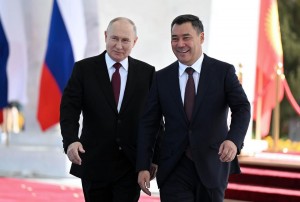 Western European companies are avoiding sanctions imposed on Russia by trading via third countries – and central Asian economies are cashing in. Since Russia’s full-scale invasion of Ukraine in February 2022, there has been a campaign of moral and material support for Ukraine by Western countries wanting to protect the Ukrainian people and oppose Moscow’s aggression.Alongside this, it was emphasized that companies, both state and private, should withdraw and cease trading with Russia. Many have complied, and sanctions have been strong and corrosive in areas such as energy, finance, and technology.
Western European companies are avoiding sanctions imposed on Russia by trading via third countries – and central Asian economies are cashing in. Since Russia’s full-scale invasion of Ukraine in February 2022, there has been a campaign of moral and material support for Ukraine by Western countries wanting to protect the Ukrainian people and oppose Moscow’s aggression.Alongside this, it was emphasized that companies, both state and private, should withdraw and cease trading with Russia. Many have complied, and sanctions have been strong and corrosive in areas such as energy, finance, and technology.
The impact of isolation has been felt in Russia and many of its citizens have left the country. Moscow has sought to compensate for this loss by making it easier for citizens of Kazakhstan, Belarus, and Moldova to obtain Russian citizenship, including by relaxing the requirement to know Russia’s history and laws.
In the first months after the full-scale invasion, Ukraine was viewed by many in the West as a buffer zone between Europe and Russia. But some European countries, after loudly and uncompromisingly expressing their support for Kyiv, have since adopted a more security-oriented view, putting the problems of the Ukrainian people on the back burner. Even the initial openness over Ukrainian refugees has gradually faded.
We are now in what might be called the third phase, a period in which the willingness of some European countries to trade with Russia has become clear.
Major European economies are quietly continuing their economic cooperation with Moscow by circumventing sanctions to take advantage of the vacated market. And they’re doing it by finding partners in the South Caucasus and Central Asia.
Countries in the region, Kyrgyzstan in particular, are acting as conduits so Europe can maintain its economic ties with Russia, according to data published by Robin Brooks, chief economist at the Institute of International Finance.
German exports of cars and auto parts to Kyrgyzstan increased by 5,500% in 2023, while they were up by 720% to Kazakhstan, 450% to Armenia, and 340% to Georgia, his report found.
The countries involved have also seen increased trade volumes with Russia. Kazakh companies exported around €550m worth of electronic equipment to Russia between January and October 2022, 18 times more than in the same period in 2021, according to the Central Asian Bureau for Analytical Reporting.
“Our results should not be read as indicating an obvious violation of export controls, as we only look at aggregate level export data, which do not shed light on what goods are being exported,” Brooks said. “The unprecedented boom in trade with Central Asia raises important questions.” He called for a comprehensive investigation of the issue.
The behavior of these countries has several explanations. They meet most of their energy needs from Russia and don’t want to risk their energy security. They also have long-standing trade ties, and severing them over Ukraine could have devastating effects.
Another reason is the desire to capitalize on the market vacuum created by those countries that have cut ties with Russia. They are already preparing for the post-war period and ensuring they will have a foothold in the market.
Questions remain about the sincerity of Western countries on Ukraine. No one knows how effective and deep the sanctions really are.
Dr Mehmet Fatih Oztarsu is a Senior Researcher at the Institute of EU Studies at Hankuk University of Foreign Studies. He studied and worked in Baku, Yerevan, Tbilisi, and Seoul as an academic and journalist. He is the author of numerous articles and books on South Caucasus and Central Asian affairs.
https://cepa.org/article/central-asia-a-lucrative-back-door-to-russia/

 Ocak 3rd, 2024
Ocak 3rd, 2024  oztarsu
oztarsu  Posted in
Posted in  Tags:
Tags: